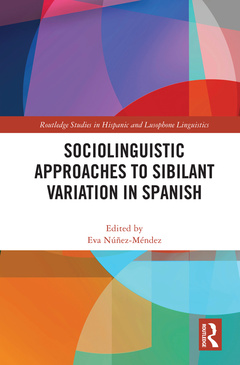Description
Sociolinguistic Approaches to Sibilant Variation in Spanish
Routledge Studies in Hispanic and Lusophone Linguistics Series
Coordinator: Núñez-Méndez Eva
Language: English
Subject for Sociolinguistic Approaches to Sibilant Variation in Spanish:
Keywords
Heritage Spanish Speakers; Dialectal variations; Minimum Adequate Model; Spanish phonetics; Vocal Fold; Spanish sibilants; L2 Spanish Speaker; Sociolinguistic factors; Spanish Language; Heritage Speakers; Intervocalic Contexts; Glottal Variants; Western Andalusia; Miami Cuban; Western Nicaragua; Andalusian Spanish; Educated Speakers; Media Lengua; Dialect Zones; Fricative Voicing; Voiced Consonant; Glottal Stops; Syllable Stress; Sibilant Variation; Sociolinguistic Interviews; Word Final Position; Glottal Constriction; Voicing Assimilation; L1 Speaker
Publication date: 01-2023
· 15.6x23.4 cm · Paperback
Publication date: 04-2021
· 15.6x23.4 cm · Hardback
Description
/li>Contents
/li>Readership
/li>Biography
/li>
Social processes and the nature of language variation have driven sibilant variation across the Spanish-speaking world. This book explores the current state of Spanish sibilants and their dialectal variations.
Focusing on different processes undergone by sibilants in Spanish (e.g., voicing, devoicing, weakening, aspiration, elision) in various geographical areas and language contact situations, each chapter offers an analysis on a unique sociolinguistic case from different formal, experimental, and data-based approaches. The opening chapter orients the reader with an overview of sibilant system?s evolution, which serves as an anchor to the other chapters and facilitates understanding for readers new to the topic. The volume is organized around three thematic sections: part one, Spain; part two, United States; and part three, Central and South America. The collection includes research on dialects in both Peninsular and Trans-Atlantic Spanish such as Jerezano, Caribbean Spanish in Boston and New York City, Cuban Spanish in Miami, Colombia-Barranquilla Spanish, northern Buenos Aires Argentine Spanish, and USA heritage Spanish, among other case studies.
This volume offers an original and concise approach to one of the most studied variables in Spanish phonetics, taking into account geographically-based phonetic variation, sociolinguistic factors, and various Spanish language contact situations. Written in English, this detailed synthesis of the wide-ranging geolinguistic features of Spanish sibilants provides a valuable resource for scholars in Hispanic studies, linguistics, Spanish dialectology and sociolinguistics.
PART I. Spain 1. An overview of the sibilant merger and its development in Spanish 2. Sibilants in Western Andalusian Spanish: the lack of a Sevillian norm in the Jerezano speech community 3. Intervocalic /s/-voicing in Spanish in contact with Catalan PART II. United States 4. Describing and analyzing variability in Spanish /s/: a case study of Caribbeans in Boston and New York City 5. Variable realization of final /s/ in Miami Cuban Spanish: the reversal of diachronic language change 6. Variable /s/-voicing by heritage Spanish speakers in the United States PART III. Central and South America 7. /s/ weakening in Nicaragua 8. A sociophonetic approach to /s/-realization in the Colombian Spanish of Barranquilla 9. Sibilants in Ecuadoran Spanis 10. Syllable-final /s/-variation in an Uruguayan Spanish-Portuguese contact variety 11. Variable voicing in Argentine Spanish /ʒ/
Eva Núñez is Professor of Spanish Linguistics at Portland State University, USA.




